
Dendritic Opals: Abakɔsɛm, Nsɛnkyerɛnnede, Nkyerɛase & Nea Ɛkeka Ho!
 Ebia wɔn a wɔpɛ aboɔden abo behu asɛmfua “dendritic” wɔ aboɔden abo ahorow kakraa bi mu. Aboɔden abo a ɛte saa no biako ne dendritic opal, opal bi a nneɛma a ɛyɛ tumm ka ho a ɛyɛ nsusuwso a ɛyɛ nwonwa a ɛte sɛ fern wɔ ɔbo no ani.
Ebia wɔn a wɔpɛ aboɔden abo behu asɛmfua “dendritic” wɔ aboɔden abo ahorow kakraa bi mu. Aboɔden abo a ɛte saa no biako ne dendritic opal, opal bi a nneɛma a ɛyɛ tumm ka ho a ɛyɛ nsusuwso a ɛyɛ nwonwa a ɛte sɛ fern wɔ ɔbo no ani.
Sɛ yɛbɛka no ɔkwan biara so a, dɛn ne dendritic aboɔden abo?
Abɔde a nkwa wom ho animdefo nim dendrites sɛ ntini mu nkwammoaa a ɛyɛ nkorabata ano a ɛne dendrite afoforo di nkitaho wɔ synapses so de nkrasɛm fa nipadua no mu. Aboɔden abo ho animdefo de asɛmfua “dendrites” di dwuma de kyerɛ agyiraehyɛde ahorow a ɛte sɛ dua wɔ aboɔden abo anaa ɔbotan bi so. Sɛ opal anaa aboɔden abo biara da nneɛma a wɔde ka ho a ɛte sɛ dua adi a, aboɔden abo ho animdefo frɛ no saa ɔbo no mu “dendritic” ahorow.
Wɔ honhom famfo mu no, dendritic opal kura nkonyaayi tumi ahorow a emu yɛ den, na wɔtaa de sa honam fam, nkate fam, ne honhom fam nyarewa.
Ɛnnɛ, yɛbɛka dendritic opal nteaseɛ, abakɔsɛm, ne agyapadeɛ, asase ne honhom fam nyinaa ho asɛm. Momma yɛnhyɛ aseɛ wɔ geological fã no na yɛnhwɛ deɛ dendritic opal yɛ ankasa.
Dɛn Ne Dendritic Opal?
Dendritic opal yɛ opal a wɔtaa de di dwuma (a ɛnkyerɛ kɔla a wɔde di agoru biara) a nea ɛda nsow ne nea ɛka ho a ɛda nsɔe anaa nkorabata nsusuwso adi. Saa nhyehyɛe ahorow a wɔde ka ho yi nso ama wɔde edin foforo “moss opal” anaa “mossy opal” aba.
Sɛ yɛbɛhwɛ a, inclusions yɛ ade biara a ɛbɛkyere wɔ mineral foforo mu bere a mineral no reyɛ no. Dendritic a ɛtaa ka saa opal ahorow yi ho ne dade oxides te sɛ manganese ne dade.
Dendritic opal nipadua mu nne taa yɛ fitaa anaa kɔkɔɔ-biribiri a ɛyɛ nufusu, opalescent sheen ne resinous luster. Nea ɛka ho no yɛ tuntum, mpɛn pii no tuntum, ahabammono tuntum, anaa bruu. Ɔbo no taa yɛ nea wontumi nhu nanso ɛtɔ mmere bi a ɛyɛ hann, anaasɛ n’abien nyinaa a wɔaka abom.
Natural opalite , a ɛwɔ nipadua kɔla a ɛyɛ ahabammono a ɛyɛ nsɔe na ebetumi ada chatoyancy adi no nso betumi ayɛ dendritic inclusions a ɛyɛ tuntum, fitaa, anaa bruu-tuntum. Wɔfrɛ saa ahorow yi dendritic opalite.
Ɔkwan bɛn so na wɔyɛ dendritic opal?
Dendritic opal a ɛba no ba sɛnea ɛte wɔ opal afoforo ho no. Asase ase nsu fa silica kurukuruwa na ɛkɔtra kotoku mu wɔ asase ase, na ɛyɛ den nkakrankakra ma ɛbɛyɛ opal.
Nanso, nsu-aboɔden abo ano aduru a awiei koraa no ɛyɛ dendritic opal no nso wɔ manganese ne/anaasɛ dade aboɔden abo a ɛyɛ ɔbo no mu nneɛma a ɛka ho bere a ɛyɛ den no. Sɛ dendritic opal yɛ den wie a, ne fã a ɛnyɛ den no taa te sɛ bobe anaa asaabo.
Seesei wunim mineral afã no, nanso dendritic opal su sɛ aboɔden abo nso ɛ?
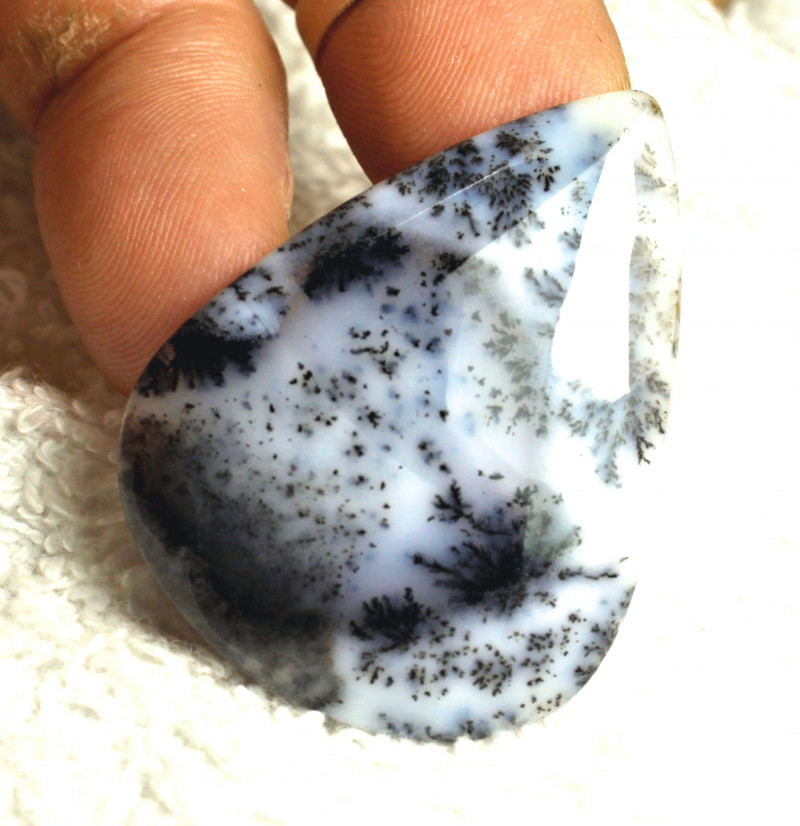
Dendritic Opal Aboɔden Aboɔ Nneɛma a Ɛwɔ Hɔ
Aboɔden aboɔ agyapadeɛ boa aboɔden aboɔ ho animdefoɔ ne agudeyɛfoɔ ma wɔhunu boɔ a aboɔden aboɔ bi som, enti adetɔfoɔ nim sɛ wɔretua boɔ a ɛfata wɔ aboɔden aboɔ no su ho. Opal yɛ abo a ɛyɛ anifere sen biara a ɛsɛ sɛ wobu no sɛ ɛsom bo no mu biako, .
Dendritic opal su atitiriw a wɔde kyerɛ ne bo a ɛsom wɔ opal ne ne ka ho nhyehyɛe ne nea wɔatwa.
Dendritic opal inclusions betumi ayɛ nsusuwii ahorow, na nsusuwii biara yɛ soronko. Sɛ nhwɛso no, wɔato dendritic opal a nneɛma a ɛka ho te sɛ kwae mu nsase no din “asase so opal.”
Dendritic opals a nsu bɛyɛ ɔha biara mu nkyem 30 na ɛwom no yɛ “aboɔden abo a ɛyɛ mmerɛw.” Mpɛn pii no, ɛnyɛ den sɛ wobetwitwa aboɔden abo a ɛyɛ mmerɛw na wɔayɛ no sɛnea ɛte, nanso dendritic opal a wɔde ka ho no ma saa adeyɛ yi yɛ anifere. Mpɛn pii no, wubehu sɛ wɔatwitwa wɔn sɛ nkuruwankuruwa anaa cabochons .
Dendritic Opal ne Dendritic Agate a wɔde di dwuma
Sɛ woretɔ aboɔden abo a, ebia wubehu abo a ɛte sɛ nea ɛte saa ara a wɔfrɛ no dendritic agate no. Nsonsonoe bɛn na ɛda dendritic agate ne dendritic opal ntam?
Dendritic agate ne dendritic opal nyinaa yɛ silicate ahorow a ɛwɔ nneɛma a ɛyɛ tumm a ɛte sɛ nnua, nanso ɛsono abo no wɔ akwan atitiriw kakraa bi so:
Mineral Family: Dendritic agate yɛ chalcedony a ɛwɔ banded, bere a dendritic opal yɛ opal ahorow.
Ahwehwɛ Nhyehyɛe: Dendritic agate wɔ ahwehwɛ nhyehyɛe a ɛyɛ ahinanan, nanso dendritic opal yɛ nea enni nsɛ (a enni ahwehwɛ nhyehyɛe).
Aboɔden abo Gyinabea: Agate yɛ aboɔden abo, bere a dendritic opal yɛ aboɔden abo . Sɛ yɛbɛhwɛ a, mineraloids te sɛ mineral nanso enni crystalline structures na ɛkyerɛ nnuru ahodoɔ a ɛtrɛ sene minerals.
Hardness: Dendritic agate di 7 wɔ Mohs mineral hardness scale , bere a dendritic opal di 5.5 kosi 6, te sɛ opal dodow no ara.
Mmeae: Dendritic agate dodow no ara fi Brazil, India, ne Mexico. Dendritic opal dodow no ara fi Australia, Mexico, ne USA.
Nea ɛyɛ anigye no, ɛtɔ mmere bi a dendritic opalite nya nea ɛka ho no fi dendritic agate a ɛwɔ hɔ bere a wɔreyɛ no mu.
Yenim nneɛma bɛn na ɛka ne hyehyɛ, nanso ɔkwan bɛn so na dendritic opal aka aman ahorow so nkɛntɛnso bere tenten?
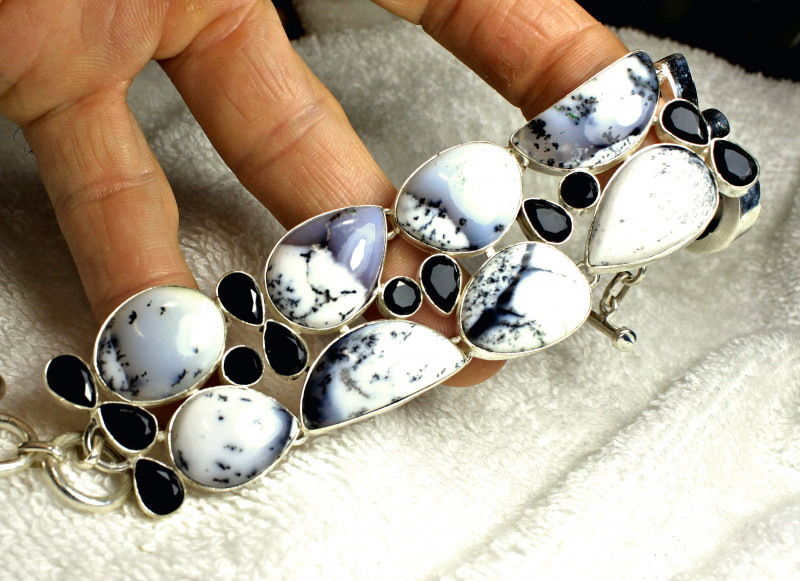
Dendritic Opal Abakɔsɛm & Fibea
Asɛmfua “dendrite” no fi Tete Hela dendritēs, a ɛkyerɛ “ɛte sɛ dua,” a wonya fii dendron , a ɛkyerɛ “dua” mu. Asɛmfua “opal” no fi Latin kasa mu opallus , a ɛkyerɛ “ɔbo a ɛsom bo,” anaa Tete Hela kasa opallios , a ɛkyerɛ “sɛ wohu kɔla a ɛsakra.”
Dendritic opal a edi kan a aban mpanyimfo huu no ne afeha a ɛto so 19 mu, bere a Germanni asase ho nimdefo Johannes Menge huu opal a edi kan a wɔtaa hu wɔ Australia bɛyɛ 1849 mu no.
Bere a wɔn a wotu fam huu Australia opal akorae akɛse no, ɔbo no din yɛɛ kɛse wɔ wiase nyinaa. Ahemfo ne sɛ wɔkyekyem pɛpɛɛpɛ a, ɔman mma nyinaa siesiee wɔn ho wɔ ɔbo no mu, na ɛmaa Australia nyaa dibea a ɛwɔ hɔ mprempren sɛ wiase no mu ɔman a wɔyɛ opal sen biara.
Mprempren, ɛhe na wohu dendritic opal? Na so dendritic opal ho yɛ na?
Dendritic opal yɛ aboɔden abo a ɛdɔɔso yiye a wɔtow abo wɔ wiase nyinaa, ɛwom sɛ abo yi mu dodow no ara da so ara fi Australia de. Mpɔtam afoforo a agye din ne Mexico ne USA, baabi a wɔn a wotu fam wɔ Virgin Valley, Nevada, yɛ dendritic opal ahorow bi a ɛyɛ hann a ɛhyerɛn wɔ ahabammono a ɛyɛ hyew mu.
Wubetumi nso ahu dendritic opal deposits wɔ:
Austria
Brazil
Cuba
Guatemala
Honduras na ɛwɔ hɔ
Indonesia
Kazakhstan na ɛwɔ hɔ
Japan
Russia
Slovakia na ɛwɔ hɔ
Spain
Tanzania na ɛwɔ hɔ
Bere kɔ so no, aboɔden abo taa sesa din anaasɛ ɛboaboa abodin foforo ano. Wɔ dendritic opal fam no, mpɛn pii no wubehu sɛ wɔakyekyere no wɔ edin “merlinite” no ho.
Dendritic Opal ne Merlinite ntam nkitahodi
So nsonsonoe wɔ merlinite ne dendritic opal ntam? Anaasɛ ɛyɛ dendritic opal merlinite?
Merlinite yɛ abodin a wɔde di dwuma wɔ ahwehwɛ ayaresa kuw mu ma dendritic opal, ɛwom sɛ ebinom de “merlinite” di dwuma ma dendritic agate, psilomelane, anaa indigo gabbro nso de. Wɔde anansesɛm mu nkonyaayifo Merlin din too din no, na efi dendritic opal a wɔkyerɛ sɛ ɛyɛ nkonyaayi tumi no mu.
Wɔ saa nkyerɛwde no so no, dɛn na ɛsɛ sɛ yehu fa Merlinite dendritic opal ntease ho?
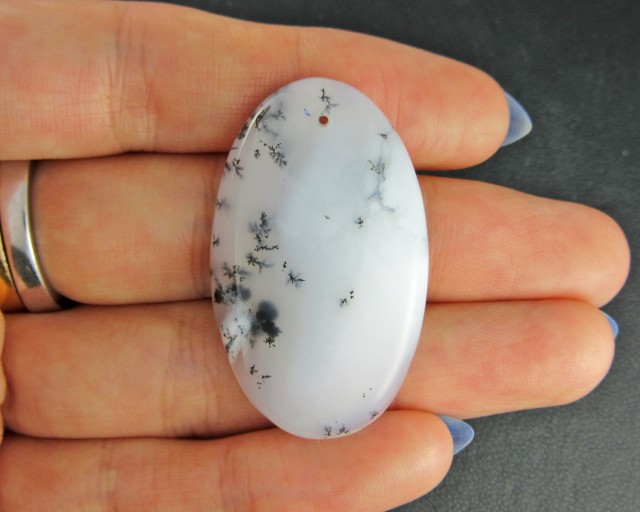
Dendritic Opal Nkyerɛase & Nsɛnkyerɛnnede
Sɛ wɔwoo wo wɔ October mu a, dendritic opal yɛ wo amammerɛ kwan so awobo , opal, a ɛyɛ dɔte. Wɔ nsoromma mu hwɛ mu no, dendritic opal yɛ okyinnsoromma so ɔbo ma owia, na ɛma ɛyɛ anigye aduru ma nsoromma mu hwɛ Leo.
Abakɔsɛm mu no, dendritic opal honhom mu ntease no bata nkonyaayi ne tumi ho. Wɔ Mfinimfini Mmere no mu no, na nkurɔfo susuwii sɛ saa abo yi kura ahintasɛm ahoɔden ahorow, na ɛma obiara a okura bi no hu ne nipasu ankasa. Ná atitiriw bɛsoa wɔn sɛ dibea ho sɛnkyerɛnne, na wogye di nso sɛ ɔbo no betumi aboa wɔn ma wɔakɔ so adi tumi.
Ná wɔn a wosua abayisɛm anaa wɔyɛ no gye di sɛ dendritic opal betumi ama wɔn akɔmfosɛm anaa wɔn tumi ayɛ kɛse, na wɔtaa de opal no si wɔn nkyɛn anaasɛ wɔde di dwuma wɔ amanne ahorow mu.
Wɔ nnɛyi honhom mu nkuruwankuruwa mu no, dendritic opal ahorow a ɛyɛ sum, a ɛne wɔn ani fitaa bɔ abira no yɛ nneɛma a ɛne ne ho bɔ abira a ɛkari pɛ ho sɛnkyerɛnne — a ɛte sɛ yin ne yang. Bio nso, sɛnea nhwɛso ahorow no te sɛ abɔde no gyina hɔ ma abusuabɔ a obi ne Asase wɔ, na ɛma nhumu ne ne ho a ohu no yɛ kɛse.
Wɔ ne fekubɔ ahorow akyi no, dɛn na dendritic opal ye ma?

Dendritic Opal Ayaresa Nneɛma
Esiane sɛ wɔde abodin bi bata abakɔsɛm mu nkonyaayifo a wɔagye din sen biara no mu biako ho nti, akyinnye biara nni ho sɛ dendritic opal, anaa “merlinite” no kura ayaresa tumi ahorow bi a ɛyɛ nkonyaayi ankasa.
Wɔ nipadua mu no, dendritic opal boa mogya a ɛkɔ nipadua no mu ne nipadua mu ahoɔden a ɛko tia nyarewa no. Crystal ayaresafo pii nso de sa adwenemhaw, ɔfe, ne asaabo ho nsɛm.
Wɔ nkate fam no, wɔtaa de dendritic opal di dwuma de nyin ankasa na ɛtew adwennwen so. Wɔkyerɛ sɛ ɔbo no boa nkate fam akwahosan denam wo ho ban fi tumi anaa nnipa a awuduru wom ho, ne tema ne boasetɔ kɛse a ɛma wunya no so.
Akyinnye biara nni ho sɛ honhom mu ayaresa ne nea agye din sen biara wɔ dendritic opal a wɔde di dwuma no mu. Wɔkyerɛ sɛ ɔbo no ma honhom mu nhumu yɛ kɛse, na ɛde amansan tumi ahorow a ɛreyɛ adwuma no ho nkate ne ntease kɛse ba.
Wɔtaa frɛ no Shaman ɔbo, dendritic opal yɛ kɛse ma obiara a ɔrehwehwɛ asetra a atwam, clairvoyance, anaa ɔsoro abɔde mu. Sɛ wɔde di dwuma wɔ nsusuwii a emu dɔ mu a, ebia dendritic opal bɛma woanya w’asetra a atwam no ho anisoadehu a emu da hɔ, na ama woanya wo mprempren honhom mu kwan ne w’atirimpɔw ho nhumu.
Sɛ wopɛ ahoɔden ayaresa a, chakra bɛn na ɛyɛ dendritic opal?
Dendritic Opal Chakra a ɛwɔ nipadua no mu
Dendritic opal ne abotiri chakra no hyia. Saa chakra yi a ɛwɔ ahoɔden halo a ɛrehuruhuruw mu wɔ ti no atifi pɛɛ no ne chakra a ɛto so ason na ɛkorɔn sen biara. Ɛkyerɛ wo nkitahodi ne nkitahodi a wo ne amansan no honhom fam fã, ne nsusuwii a enni adwene nso kwan.
Esiane sɛ abotiri chakra no na ɛhwɛ ntini ahorow no so, baabi a yɛn abɔde mu dendrites no wɔ nti, ɛte sɛ nea ɛfata sɛ ɔbo no bɛkari pɛ!
Sɛ wɔasiw abotiri chakra no ano a, ebia wobɛte nka sɛ w’abam abu, wunnya nnyinaso, anaasɛ wuntumi nnyina nsusuwii foforo ano. Wubetumi de dendritic opal adi dwuma de abue chakra no bio, akanyan w’adwene ma woagye amansan no nyansa atom.
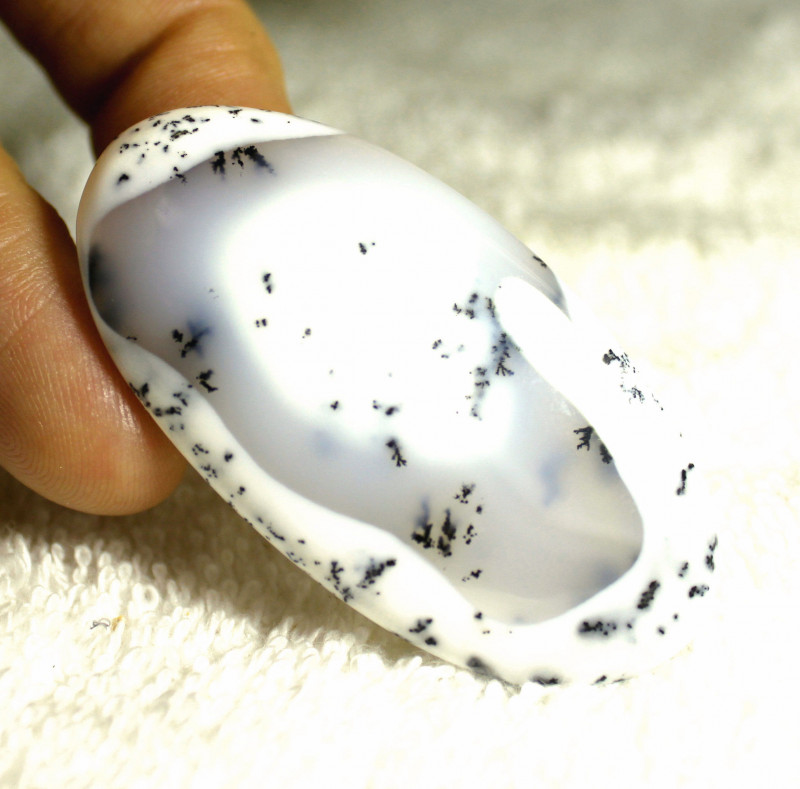
Dendritic Opal a Wɔde Dendritic Opal Yɛ Baa Dwumadibea!
Wɔ opals wiase a ɛtrɛw no mu no, dendritic opal yɛ asase mu ahorow a eye ma obiara a ɔrehwehwɛ abohene a ɛyɛ soronko te sɛ wɔn. Dendritic opals a ɛwɔ hɔ sɛ cabochons , slices, rough specimens , ne agude , betumi ama dan anaa atade biara akɔ soro ntɛm ara.
Sɛ́ ebia woreyɛ accessorizing ama ahintasɛm aesthetic, betumi de honhom mu nkɔso bi adi dwuma, anaasɛ wopɛ sɛ wode abɔde afã bi a ɛma ahotɔ ka wo ho no, dendritic opal yɛ aboɔden abo a edi mũ ma adwuma no!
搜尋Opal Encyclopedia
相關拍賣
相關文章
Crystal opal yɛ opal bi a agye din wɔ ne translucence ne vibrant iridescence ho. Wɔ akwankyerɛ yi mu no, yɛbɛfa biribiara a ɛsɛ sɛ wuhu fa ɔbo fɛfɛ yi ho.
17th Jul 2018
Sua opal ahorow ne ntease ahorow a ɛwɔ akwankyerɛ a ɛkɔ akyiri yi mu nyinaa ho ade, ne sɛnea wobɛkyekyɛ mu sɛnea kɔla, nea ɛka ho, sɛnea wɔhyehyɛ, mfiase, ne nea ɛkeka ho.
22nd May 2017
Green opals yɛ opal aboɔden abo a wɔtaa de di dwuma a ɛnyɛ iridescent no mu ahorow a ɛyɛ nwonwa. Wɔ akwankyerɛ yi mu no, yɛbɛkyerɛkyerɛ biribiara a wubetumi apɛ sɛ wuhu fa ɔbo fɛfɛ yi ho mu.
3rd Oct 2021
最新的文章
Black opals ne opal ahorow a wɔhwehwɛ sen biara, na ne nnyinaso a emu dɔ ma nyankontɔn a ɛyɛ hann wɔ soro. Hu sɛnea wɔde opal tuntum di dwuma, ne su, abakɔsɛm, ne bo a ɛsom!
7th Dec 2025
Hu sɛnea wɔde opal ahorow hyehyɛ mu ne nneɛma a ɛka ne bo. Efi kɔla ne hann so kosi nea wɔatwa ne nea efi mu ba so, sua sɛnea wɔbu opal ahorow biara bo - a nhwɛso ne bo ahorow.
19th Jul 2023
Bra akwantuo mu na sua opals ayaresa tumi ho asɛm firi yɛn ahɔhoɔ kyerɛwfoɔ Vivien Schapera a ɔfiri Crystal Healing Techniques hɔ!
20th May 2023
文章類別
All there is to know about Opals including Black Opals, Ethiopian Opals & Boulder Opal
14文章
Check out our fascinating information and articles on all things amazing in the Opal world
41文章


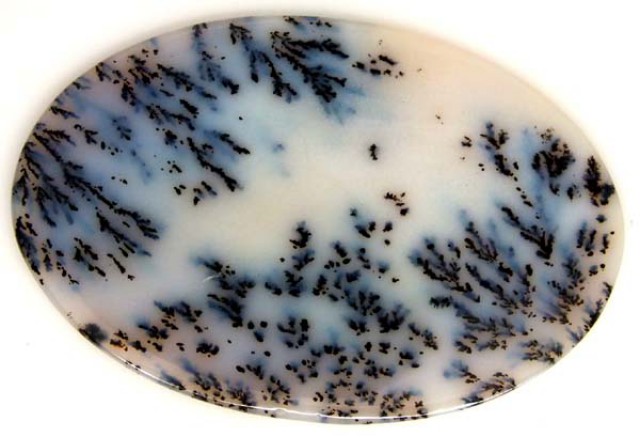

![DENDRITIC OPAL ROUGH [FJP2706 ]](https://liveplatforms-production.b-cdn.net/tenants/oa/uploads/images/120000-124999/122766/122766_1219019288.jpg?width=480&aspect_ratio=1001%3A1000)
![DENDRITIC OPAL ROUGH [S634 ]](https://liveplatforms-production.b-cdn.net/tenants/oa/uploads/images/115000-119999/116851/116851_3.jpg?width=480&aspect_ratio=1001%3A1000)
![DENDRITIC OPAL ROUGH [S632 ]](https://liveplatforms-production.b-cdn.net/tenants/oa/uploads/images/115000-119999/116848/116848_4.jpg?width=480&aspect_ratio=1001%3A1000)
![DENDRITIC OPAL ROUGH [S631 ]](https://liveplatforms-production.b-cdn.net/tenants/oa/uploads/images/115000-119999/116847/116847_4.jpg?width=480&aspect_ratio=1001%3A1000)